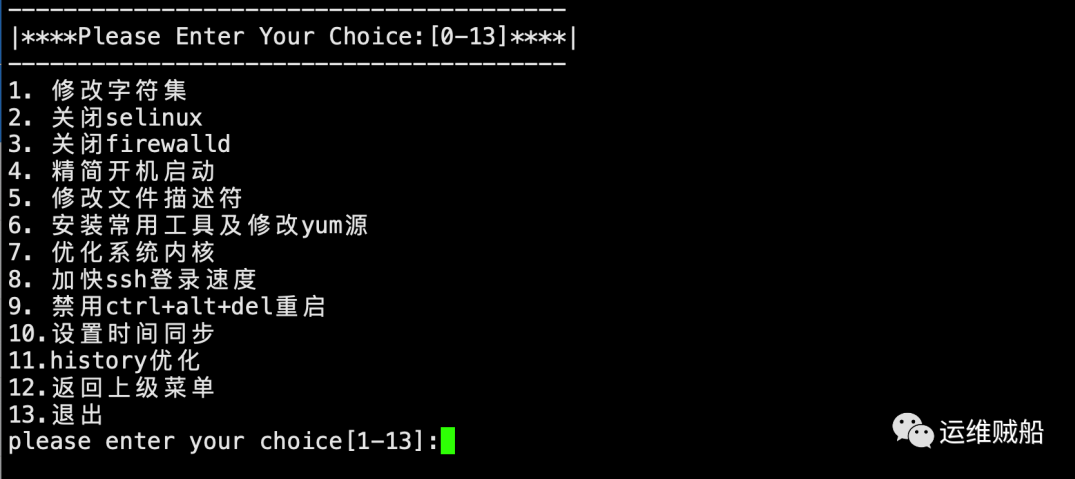请注意,本文编写于 551 天前,最后修改于 551 天前,其中某些信息可能已经过时。
目录
一、介绍
作为一名运维,经常会部署各种用途的操作系统,但在这些工作中,我们会发现很多工作其实是重复性的劳动,操作的内容也是大同小异,基于这类情况,我们可以把相同的操作做成统一执行的脚本,不同的东西作为变量手动输入。节约下来的时间不就可以做更多有意义的事情吗?
最近在粉丝有推荐下发现一款比较好用的shell源码,也基于此改编了一下,分享给大家。
二、菜单
主菜单:

二级菜单:

主要实现系统的各类优化,比如常用的修改字符集、关闭selinux、关闭防火墙、安装常用工具和加快ssh登录等功能。
三、源码
#!/bin/sh . /etc/rc.d/init.d/functions export LANG=zh_CN.UTF-8 #一级菜单 menu1() { clear cat <<EOF ---------------------------------------- |**** 欢迎使用cetnos7.9优化脚本 ****| |**** 博客地址:aaa.al ****| ---------------------------------------- 1. 一键优化 2. 自定义优化 3. 退出 EOF read -p "please enter your choice[1-3]:" num1 } #二级菜单 menu2() { clear cat <<EOF ---------------------------------------- |****Please Enter Your Choice:[0-13]****| ---------------------------------------- 1. 修改字符集 2. 关闭selinux 3. 关闭firewalld 4. 精简开机启动 5. 修改文件描述符 6. 安装常用工具及修改yum源 7. 优化系统内核 8. 加快ssh登录速度 9. 禁用ctrl+alt+del重启 10.设置时间同步 11.history优化 12.返回上级菜单 13.退出 EOF read -p "please enter your choice[1-13]:" num2 } #1.修改字符集 localeset() { echo "========================修改字符集=========================" cat > /etc/locale.conf <<EOF LANG="zh_CN.UTF-8" #LANG="en_US.UTF-8" SYSFONT="latarcyrheb-sun16" EOF source /etc/locale.conf echo "#cat /etc/locale.conf" cat /etc/locale.conf action "完成修改字符集" /bin/true echo "===========================================================" sleep 2 } #2.关闭selinux selinuxset() { selinux_status=`grep "SELINUX=disabled" /etc/sysconfig/selinux | wc -l` echo "========================禁用SELINUX========================" if [ $selinux_status -eq 0 ];then sed -i "s#SELINUX=enforcing#SELINUX=disabled#g" /etc/sysconfig/selinux setenforce 0 echo '#grep SELINUX=disabled /etc/sysconfig/selinux' grep SELINUX=disabled /etc/sysconfig/selinux echo '#getenforce' getenforce else echo 'SELINUX已处于关闭状态' echo '#grep SELINUX=disabled /etc/sysconfig/selinux' grep SELINUX=disabled /etc/sysconfig/selinux echo '#getenforce' getenforce fi action "完成禁用SELINUX" /bin/true echo "===========================================================" sleep 2 } #3.关闭firewalld firewalldset() { echo "=======================禁用firewalld========================" systemctl stop firewalld.service &> /dev/null echo '#firewall-cmd --state' firewall-cmd --state systemctl disable firewalld.service &> /dev/null echo '#systemctl list-unit-files | grep firewalld' systemctl list-unit-files | grep firewalld action "完成禁用firewalld,生产环境下建议启用!" /bin/true echo "===========================================================" sleep 5 } #4.精简开机启动 chkset() { echo "=======================精简开机启动========================" systemctl disable auditd.service systemctl disable postfix.service systemctl disable dbus-org.freedesktop.NetworkManager.service echo '#systemctl list-unit-files | grep -E "auditd|postfix|dbus-org\.freedesktop\.NetworkManager"' systemctl list-unit-files | grep -E "auditd|postfix|dbus-org\.freedesktop\.NetworkManager" action "完成精简开机启动" /bin/true echo "===========================================================" sleep 2 } #5.修改文件描述符 limitset() { echo "======================修改文件描述符=======================" echo '* - nofile 65535'>/etc/security/limits.conf ulimit -SHn 65535 echo "#cat /etc/security/limits.conf" cat /etc/security/limits.conf echo "#ulimit -Sn ; ulimit -Hn" ulimit -Sn ; ulimit -Hn action "完成修改文件描述符" /bin/true echo "===========================================================" sleep 2 } #6.安装常用工具及修改yum源 yumset() { echo "=================安装常用工具及修改yum源===================" yum install wget -y &> /dev/null if [ $? -eq 0 ];then cd /etc/yum.repos.d/ \cp CentOS-Base.repo CentOS-Base.repo.$(date +%F) ping -c 1 mirrors.aliyun.com &> /dev/null if [ $? -eq 0 ];then wget -O /etc/yum.repos.d/CentOS-Base.repo http://mirrors.aliyun.com/repo/Centos-7.repo &> /dev/null yum clean all &> /dev/null yum makecache &> /dev/null else echo "无法连接网络" exit $? fi else echo "wget安装失败" exit $? fi yum -y install ntpdate lsof net-tools telnet vim lrzsz tree nmap nc sysstat &> /dev/null action "完成安装常用工具及修改yum源" /bin/true echo "===========================================================" sleep 2 } #7. 优化系统内核 kernelset() { echo "======================优化系统内核=========================" chk_nf=`cat /etc/sysctl.conf | grep conntrack |wc -l` if [ $chk_nf -eq 0 ];then cat >>/etc/sysctl.conf<<EOF net.ipv4.tcp_fin_timeout = 2 net.ipv4.tcp_tw_reuse = 1 net.ipv4.tcp_tw_recycle = 1 net.ipv4.tcp_syncookies = 1 net.ipv4.tcp_keepalive_time = 600 net.ipv4.ip_local_port_range = 4000 65000 net.ipv4.tcp_max_syn_backlog = 16384 net.ipv4.tcp_max_tw_buckets = 36000 net.ipv4.route.gc_timeout = 100 net.ipv4.tcp_syn_retries = 1 net.ipv4.tcp_synack_retries = 0 net.core.somaxconn = 16384 net.core.netdev_max_backlog = 16384 net.ipv4.tcp_max_orphans = 16384 net.netfilter.nf_conntrack_max = 25000000 net.netfilter.nf_conntrack_tcp_timeout_established = 180 net.netfilter.nf_conntrack_tcp_timeout_time_wait = 120 net.netfilter.nf_conntrack_tcp_timeout_close_wait = 60 net.netfilter.nf_conntrack_tcp_timeout_fin_wait = 120 EOF sysctl -p else echo "优化项已存在。" fi action "内核调优完成" /bin/true echo "===========================================================" sleep 2 } #8.加快ssh登录速度 sshset() { echo "======================加快ssh登录速度======================" sed -i 's#^GSSAPIAuthentication yes$#GSSAPIAuthentication no#g' /etc/ssh/sshd_config sed -i 's/#UseDNS yes/UseDNS no/g' /etc/ssh/sshd_config systemctl restart sshd.service echo "#grep GSSAPIAuthentication /etc/ssh/sshd_config" grep GSSAPIAuthentication /etc/ssh/sshd_config echo "#grep UseDNS /etc/ssh/sshd_config" grep UseDNS /etc/ssh/sshd_config action "完成加快ssh登录速度" /bin/true echo "===========================================================" sleep 2 } #9. 禁用ctrl+alt+del重启 restartset() { echo "===================禁用ctrl+alt+del重启====================" rm -rf /usr/lib/systemd/system/ctrl-alt-del.target action "完成禁用ctrl+alt+del重启" /bin/true echo "===========================================================" sleep 2 } #10. 设置时间同步 ntpdateset() { echo "=======================设置时间同步========================" yum -y install ntpdate &> /dev/null if [ $? -eq 0 ];then /usr/sbin/ntpdate time.windows.com echo "*/5 * * * * /usr/sbin/ntpdate ntp.aliyun.com &>/dev/null" >> /var/spool/cron/root else echo "ntpdate安装失败" exit $? fi action "完成设置时间同步" /bin/true echo "===========================================================" sleep 2 } #11. history优化 historyset() { echo "========================history优化========================" chk_his=`cat /etc/profile | grep HISTTIMEFORMAT |wc -l` if [ $chk_his -eq 0 ];then cat >> /etc/profile <<'EOF' #设置history格式 export HISTTIMEFORMAT="[%Y-%m-%d %H:%M:%S] [`whoami`] [`who am i|awk '{print $NF}'|sed -r 's#[()]##g'`]: " #记录shell执行的每一条命令 export PROMPT_COMMAND='\ if [ -z "$OLD_PWD" ];then export OLD_PWD=$PWD; fi; if [ ! -z "$LAST_CMD" ] && [ "$(history 1)" != "$LAST_CMD" ]; then logger -t `whoami`_shell_dir "[$OLD_PWD]$(history 1)"; fi; export LAST_CMD="$(history 1)"; export OLD_PWD=$PWD;' EOF source /etc/profile else echo "优化项已存在。" fi action "完成history优化" /bin/true echo "===========================================================" sleep 2 } #控制函数 main() { menu1 case $num1 in 1) localeset selinuxset firewalldset chkset limitset yumset kernelset sshset restartset ntpdateset historyset ;; 2) menu2 case $num2 in 1) localeset ;; 2) selinuxset ;; 3) firewalldset ;; 4) chkset ;; 5) limitset ;; 6) yumset ;; 7) kernelset ;; 8) sshset ;; 9) restartset ;; 10) ntpdateset ;; 11) historyset ;; 12) main ;; 13) exit ;; *) echo 'Please select a number from [1-13].' ;; esac ;; 3) exit ;; *) echo 'Err:Please select a number from [1-3].' sleep 3 main ;; esac } main $*
将其保存为init.sh,然后赋予执行权限后执行即可。
chmod +x init.sh && ./init.sh
如果这样来回地复制粘贴很麻烦,也可以通过我的一键命令执行,同样能达到上面的效果:
bash -c "$(curl -L s.aaa.al/init.sh)"
最后,如果大家有想实现的功能,也可以在原有脚本的基础上进行修改实现。
如果对你有用的话,可以打赏哦
打赏


本文作者:Gustav
本文链接:
版权声明:本博客所有文章除特别声明外,均采用 BY-NC-SA 许可协议。转载请注明出处!
目录
